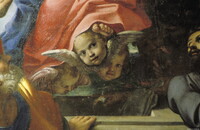| dc.coverage.spatial | Site: Santa Maria del Popolo (Rome, Lazio, Italy) | en_US |
| dc.coverage.temporal | ca. 1600-1601 (creation) | en_US |
| dc.creator | Caravaggio, Michelangelo Merisi da | en_US |
| dc.creator | Carracci, Annibale | en_US |
| dc.date | 1600-1601 | en_US |
| dc.date.accessioned | 2013-04-12T16:38:27Z | |
| dc.date.available | 2013-04-12T16:38:27Z | |
| dc.date.issued | 1600-1601 | en_US |
| dc.identifier | 207625 | en_US |
| dc.identifier.other | archrefid: 795 | en_US |
| dc.identifier.uri | http://hdl.handle.net/1721.3/115493 | |
| dc.description | The altarpiece "Assumption of the Virgin" (by Annibale Carracci, 1601), detail depicting the faces of the two putti; The radical transformation of Annibale's style since he came to Rome could not be appreciated fully until his altarpiece of the Assumption of the Virgin for the Cerasi Chapel in S Maria del Popolo was unveiled early in 1601 (in situ). Despite the panel's relatively modest size, it has an overpowering impact. Supported by angels, the Virgin erupts from the empty tomb around which the apostles crowd, compressed together in the immediate foreground. Forms are simplified, and the almost geometrical solidity of the figures is intensified by the bright colours and sharp focus typical of panel painting. A staccato tempo of abrupt gestures, sudden twists and turns and unexpected juxtapositions forcefully communicates the picture's dramatic content, replacing the gentler, lyrical rhythms of the Pietà or the Farnese ceiling. The fact that the Assumption was to be flanked by two paintings by Caravaggio no doubt contributed to its extremist position. Faced with the challenge posed by Caravaggio's anti-idealist style, Annibale took the opposite course. His altarpiece polemicizes Caravaggio's non-selective naturalism, countering it with a conception of religious painting in which sacred figures of idealized perfection are depicted with the greatest possible verisimilitude; a conception that, moreover, had the full authority of tradition behind it. Source: Grove Art Online; http://www.groveart.com/ (accessed 1/19/2008) | en_US |
| dc.format.medium | marble; oil on canvas; fresco; stucco | en_US |
| dc.rights | © Scott Gilchrist, Archivision, Inc. | en_US |
| dc.subject | New Testament | en_US |
| dc.subject | saints | en_US |
| dc.subject | Mary, Blessed Virgin, Saint | en_US |
| dc.subject | Peter, the Apostle, Saint | en_US |
| dc.subject | Baroque | en_US |
| dc.title | Santa Maria del Popolo, Cerasi Chapel | en_US |
| dc.title.alternative | Cappella Cerasi | en_US |
| dc.type | image | en_US |
| dc.rights.access | Licensed for educational and research use by the MIT community only | en_US |
| dc.identifier.vendorcode | 1A2-I-R-SP-9-C4 | en_US |
| vra.culturalContext | Italian | en_US |
| vra.technique | oil painting (technique) intarsia | en_US |
| vra.worktype | painting (visual work) | en_US |
| dc.contributor.display | Annibale Carracci (Italian painter, 1560-1609); Michelangelo Merisi da Caravaggio (Italian painter, 1571-1610) | en_US |


